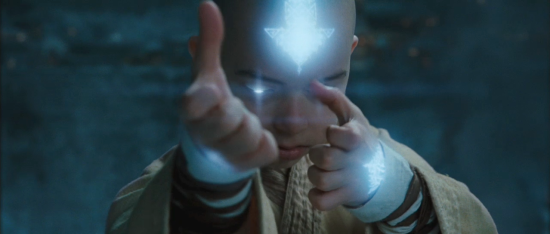What is it about Movies Called Avatar and Race?
M. Night Shyamalan‘s forthcoming adaptation of Nickelodeon’s animated series Avatar: The Last Airbender won’t be released until July 2010, but criticism over the whitewashing of the series’ Asian characters has already given birth to a thriving year-old community of dissenters at Racebending.com and preemptive discussions on whether the casting is racist.
While other movie critics were having eyegasms over Airbender’s Superbowl Ad and latest trailer, both Topless Robot and Salon.com turned to address the racial anxiety Shyamalan has stirred up by casting mostly white actors as the series’ clearly Asian and Inuit lead characters.
Salon’s Martha Nichols was unforgiving, calling Shyamalan’s Airbender “this latest example of whitewashing” that ignores the racial diversity of the original animated series “in a depressingly familiar way.” Nichols is unconvinced by Shyamalan’s justification for casting white actors as the leads:
Meanwhile, Shyamalan recently gave Nicola Peltz as Katara a “rave review” in People: “I told the studio I didn’t want to make this movie without her.”
You don’t have to be paranoid to see the spin: No other actor on Earth could compete. Shyamalan couldn’t help himself when he saw her acting splendor. (She’s white? Really?) Of course it’s not about racism, it’s about quality.
Topless Robot’s Rob Bricken, on the other hand, thinks critiques of Shyamalan’s casting ignore the pragmatic realities of Hollywood and the profit-driven entertainment industry:
You guys need to settle down, because there is no way that Hollywood would have ever, ever cast anyone other than a white kid as Aang. I think your heart is in the right place, and I think this is a discussion worth having, but you guys need to stop losing sleep over this.
Although the people in the Avatar cartoon are clearly based on actual ethnicities, it is still a fantasy. It’s much like Dragonball Z in that regard, which you might recall also starred a white kid. As long as Avatar is not set in the real world, the studios aren’t bound by anything. Would the casting for The Last Airbender be different if the story had been set in genuine Asia as opposed to the real world? Not necessarily, but I do think studios would have thought more about it before casting.
Here’s a picture of the aforementioned Aang, by the way.

But for the folks at Racebending.com, it doesn’t matter that the show’s creators Bryan Konietzko and Mike DiMartino are white, or that the world of Avatar is not meant to represent “genuine Asia”–Hollywood owes more to its diverse audiences. In response to a letter Paramount sent to the Media Action Network For Asian Americans regarding casting issues in Avatar, Racebending.com issued this statement:
This world features astonishing diversity from all across the Asian continent and all along the Pacific Rim, which is a part of what made it so unique…How can you, in good faith, say you are trying to honor the integrity of the television series by taking a story written with Asian themes, settings, characters, and populating it with white leads—especially when there are so few Asian roles available in Hollywood? You are continuing a generations-long practice of racial discrimination where the opportunity for actors of color to be heroes for a change is taken away (this time in the name of “diversity.”).
After Shyamalan’s initial casting of whites for all four lead roles led to major fan backlash, Dev Patel (of South Asian descent) was recast as Zuko, replacing white actor Jesse McCartney. This, however, failed to assuage the Racebending.com community, prompting an all-out assault on Shyamalan’s casting call rhetoric and inability to cast a person of color as a anything other than an antagonist or background character:
Decisions were made within Paramount’s leadership to systematically exclude faces of color from the forefront of The Last Airbender. When pressured to introduce diversity into the cast, Paramount carefully selected roles that were either antagonistic or inconsequential.
With new images from the Avatar trailers circulating around the Internet, the race debate has only become more intense as people scratch their heads over how three white actors can effectively represent the Asian and Inuit leading characters from the original animated series. As a much beloved series and potential summer blockbuster, it’s understandable why so many fans are greatly disappointed in what seems to be lack of respect regarding the original spirit of the show, as well as what could have been a major milestone for Asian actors in largely white Hollywood.
![]()
Even as Bricken argues “…movie studios always cast for their largest audience, and in America, that’s generally white,” what he fails to see is that those numbers are quickly changing. If Hollywood intends to remain relevant and evolve alongside the changing demographics of America, then the pragmatic casting decisions of the entertainment industry will likewise need to adapt. We may be seeing a more diverse roster of actors on the big screen in movies of the future for the exact same reason that we don’t see them now. While critics on both sides of the race debate will tell you that seeing non-white faces on the big screen hardly amounts to a radical revision of race politics in America, it can inspire a younger audience to expect more from the entertainment industry than the same rotating roster of white faces. As Nichols concludes, “Sometimes a picture really is worth a thousand words.”
Race and casting issues aside, if Shyamalan’s Avatar bombs (as one commenter suspects based on a purported viewing of the script), fans of the original animated series can take comfort knowing that no minority actors’ careers were destroyed in the making of the film.
Have a tip we should know? [email protected]